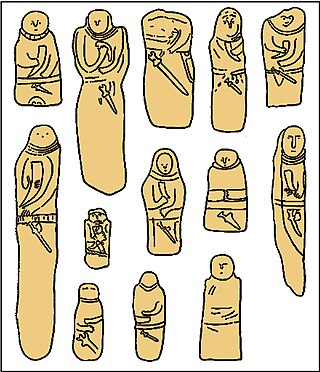
Anacharsis was a Scythian prince and philosopher of uncertain historicity who lived in the 6th century BC.

The Scythians or Scyths in composition) and sometimes also referred to as the Pontic Scythians, were an ancient Eastern Iranic equestrian nomadic people who had migrated during the 9th to 8th centuries BC from Central Asia to the Pontic Steppe in modern-day Ukraine and Southern Russia, where they remained established from the 7th century BC until the 3rd century BC.

The Cimmerians were an ancient Eastern Iranic equestrian nomadic people originating in the Pontic–Caspian steppe, part of whom subsequently migrated into West Asia. Although the Cimmerians were culturally Scythian, they formed an ethnic unit separate from the Scythians proper, to whom the Cimmerians were related and who displaced and replaced the Cimmerians.
Sadyattes was the third king of the Mermnad dynasty in Lydia, the son of Ardys and the grandson of Gyges of Lydia. Sadyattes reigned 12 years according to Herodotus.

The Agathyrsi were an ancient people belonging to the Scythian cultures who lived in the Transylvanian Plateau, in the region that later became Dacia. The Agathyrsi are largely known from Herodotus of Halicarnassus's description of them in the 5th century BC.

The Scythian languages are a group of Eastern Iranic languages of the classical and late antique period, spoken in a vast region of Eurasia by the populations belonging to the Scythian cultures and their descendants. The dominant ethnic groups among the Scythian-speakers were nomadic pastoralists of Central Asia and the Pontic–Caspian steppe. Fragments of their speech known from inscriptions and words quoted in ancient authors as well as analysis of their names indicate that it was an Indo-European language, more specifically from the Iranic group of Indo-Iranic languages.
Madyes was a Scythian king who ruled during the period of the Scythian presence in West Asia in the 7th century BCE.

Scythia or Scythica was a geographic region defined in the ancient Graeco-Roman world that encompassed the Pontic–Caspian steppe. It was inhabited by Scythians, an ancient Eastern Iranian equestrian nomadic people.

The Scythian religion refers to the mythology, ritual practices and beliefs of the Scythian cultures, a collection of closely related ancient Iranian peoples who inhabited Central Asia and the Pontic–Caspian steppe in Eastern Europe throughout Classical Antiquity, spoke the Scythian language, and which included the Scythians proper, the Cimmerians, the Sarmatians, the Alans, the Sindi, the Massagetae and the Saka.
Sandakshatru or Sandakuru was the last known Cimmerian king.

Skudra was a province (satrapy) of the Persian Achaemenid Empire in Europe between 510s BC and 479 BC. Its name is attested in Persian and Egyptian inscriptions (an Egyptian record of c. 498–497 BC, and a list on the tomb of Darius the Great at Naqsh-e Rustam, c. 486 BC. It is believed to have comprised the lands now known as Thrace and Macedon.
Spargapeithes was the name of a king of the Scythic tribe of the Agathyrsoi.
The Treres were a Thracian tribe, of whom a part invaded Anatolia in the 7th century BCE, while another part lived in Thrace and Illyria.
Bartatua or Protothyes was a Scythian king who ruled during the period of the Scythian presence in Western Asia in the 7th century BCE.
Octamasadas was a Scythian king, the son of King Ariapeithes, who lived around 446 BC. He came to power after he deposed and replaced his half-brother Scyles. Octamasadas was the son of Teres I’s daughter, making Octamasadas Teres’ grandson. Teres I was the father of Sitalces and Sparadocus, Thracian kings.

Nikōnion and Nikōnia was an ancient Greek city on the east bank of the Dniester estuary. Its ruins are located 300 meters to the northwest of the modern village Roksolany, in the Odesa Raion of the Odesa Oblast, Ukraine.
The Enarei, singular Enaree, were Scythian androgynous/effeminate priests and shamanistic soothsayers who played an important role in the Scythian religion.
Ariapeithes was a king of the Scythians in the early 5th century BCE.
Targitaos or Scythes, was the ancestral god of the Scythians according to Scythian mythology. The ancient Greeks identified him with their own hero Hēraklēs.

Sakez also known as Sekez, Sekakez and Scyth (Eskit) was a sizable urban settlement and historical ancient city in the first millennium BC in Iran. It was the political and military capital of Scythians in western Iran and one of the few ancient cities that has been the residence of people and the center of civilization and it still is. Archaeologists believe that the present-day city of Saqqez in Kurdistan is the remnant of the city of Sakez, which takes its name from the Scythians and, with a slight change in pronunciation, is still called by the same name.










